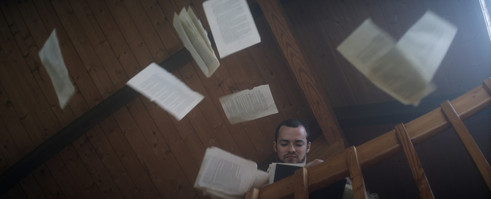
Tell us about yourself. What inspired you to become a filmmaker?
Sven Britt (Ex-Fiancée // Composer, Writer): While I’ve mostly gotta defer to Maria here, I can say what inspired me to make this work: my album was coming together and I knew that it would be a waste to not work together with my husband (Chris Masters, the film’s choreographer as well as director of the album) to build a dialectical language between words, music, and dance. A live show would be ideal (and will hopefully still happen at some point), but filming it—despite the challenges and costs inherent in such a process—proved the simpler solution at the time.
Maria Juranic (Director): As a child, I was attracted to the fantastical possibilities in the film medium, specifically after watching “Legend” and “Labyrinth,” so naturally I wanted to be part of that creation—I wanted to make magic like what I had seen on screen.
I was fascinated by photography early on, and bought my first camera—a 110 point-and-shoot—at a garage sale for $5 shortly after I immigrated to the US as a child from Yugaslavia. I have never stopped taking pictures since; unknowingly, it's how I started to see the world.
Talk about your last work. What are some of the challenges you faced during production?
MJ: We were shooting what we initially conceived of as 4 music videos in one week, though it became clear throughout the process that we were really making a dance film that existed in both narrative and experimental realms. The budget was quite tight and we had to be creative; the trick was to schedule all the scenes and shoot them in the same house where the cast and crew were staying. Frequently as we were wrapping one scene, some of the crew went off to organize a bedroom or the kitchen into a set for the next sequence. Which is to say, everyone involved was wearing multiple hats and working long hours as we shuffled between day and night shoots to knock out everything in our limited time.
SB: A Feast That Never Comes was a time-crunch from top to bottom, so the main challenge in terms of staying true to Chris’s creative process was carving out the time to construct the choreography without eating into the necessary amount of filming time, as we shot most of the dance sequences in many different locations in order to draw attention to the cyclical nature of the characters’ relationships.

My work with Chris before this project was all live, so those challenges ranged from finding space and funding to making 24 hours of music in 4 days and synchronizing 8 distinct sound zones for an immersive dance-theatre piece we created in Beijing.
What makes you want to tell stories? In other words, what are the themes/issues you want to incorporate into your work?
MJ: As an immigrant, I quickly learned that everyone has a story and a perspective. And this was the catalyst for my desire to express myself through stories, whether told through dance, music videos, or films. My work is primarily concerned with issues of diversity, displacement and belonging, and the search for connection to the metaphysical or magical.
SB: I’m chiefly interested in finding a precipice and jumping off the cliff. The “aboutness” of the work reveals itself through the creative process, which involves everything from freewriting and subject immersion to erasures of scholarly articles and digital manipulation of field recordings.
The precipice for this project was simply—or not so simply—“how does technology affect us and our relationships.” Through the process, we ended up interrogating myriad oblique topics, from mental health and digital outrage to public vs. private presentation and cycles of abuse.
But what’s most important to me in art or in storytelling is for work to function as interrogative rather than declarative. I don’t have all the answers—hell, I don’t have any answers, I hardly know if I have clearly defined questions. So creating a landscape—whether with music or dance, live performance or film—that explicitly encourages investigation rather than spoon-feeding a singular opinion or viewpoint is absolutely critical to the how and the why of my work.
Please tell us about your vision and your method of approaching a new project?
SB: Whoops, I think I just did that. The other important note is that everything is shaped by the tasks (designed by Chris) and the people in the room. There is no singular vision or truth in these topics of investigation, and the acknowledgment and embrace of the vagaries of the work being entirely dependent on the individual histories of the people in the room is key to ensure that the work can interrogate a topic rather than attempt to come to a conclusion. Art is a conversation, and declarative statements and viewpoints are frequently the end of a conversation.
MJ: This was a project where we wanted four dance films/music videos to function independently while allowing them to reveal themselves as one film. So we had to find ways to connect and intertwine the stories. I wanted to incorporate some surreal and magical elements throughout, mainly in moments existing as an extension of the characters’ states of mind. Also, because the dance choreography was site-specific and built on set, I had to create some space for that to happen while constructing all the other elements, technical and otherwise. This definitely was not the way I am used to making films, but once we understood the theme of each dance sequence—dictated by the dancers’ responses to Chris’s choreographic prompts and tactics—we were able to define the location(s) in which it belonged. Only then could we figure out the camera angles, lighting, costumes, etc. This approach took longer than most shoots, but the process of discovery was quite beautiful and led to some wonderful synergy between the movement of the camera and the dancers.
Who are your filmmaking influencers? What are the films that were influential for you?
SB: Mostly gotta defer to Maria here, but for me… Lynch is a key thematic influence, and the way Fincher tracks (or chooses not to track) character movements was key to my personal imagining of how best to film dance. And I mean, there’s a million other influences, but I’ll let Maria take over.

MJ: Although I was influenced by many directors—Lynne Ramsey, David Lynch, Terry Gilliam, Yorgos Lanthimos, Darren Aronofsky—I was specifically challenged and inspired to keep exploring and experimenting with film techniques by Michele Gondry, and it really made filmmaking fun.
More contemporary film favorites include Biutiful, Holy Motors, Ida, A Girl Walks Home Alone At Night, Mulholland Drive, We Need To Talk About Kevin, A Single Man, Maps To The Stars, Arrival, Mother!, and Brazil.
How do you think the industry is changing? How has COVID affected independent filmmaking/creation?
SB: I can hardly speak to the film side, but in music, it’s forced a lot of people to stop gigging and jamming and to focus on writing and to (hopefully) focus on craft. Due to the realities of recordings and release schedules and etc., I don’t know that we’ve yet seen the full fallout from that, but it’ll be interesting to see who has taken the time off the road to heighten their level of intentionality and craft, and who hasn’t.
What advice would you give to aspiring artists? What are some of the things they must follow/avoid?
SB: Dammit, I keep spoiling my answers with the ones before. Intentionality and craft. This might sound mean, but I could have used this advice early in my career… For my money, if you don’t put serious time and effort into developing the craft of your art and shaping your creative process with explicit intentionality, then you’ve really got no business taking up space in a crowded field.

MJ: For aspiring filmmakers heading into production, my advice would be: Be super prepared! Look under every rock and make sure you are involved with every aspect of the production. Never be shy to say what you think; even if no one is listening, you are the one that is telling the story, and you have to push it forward the way you see it. Compromises are going to happen, but I would reserve them for when you have exhausted all other options.
Do you think films/stories can bring about a change in the world?
MJ: Absolutely. Anything that inspires can spark someone to take action the next day, to feel like they are not alone in their thought or mission. Films are incredibly powerful.
SB: I mean. Insofar as any art can change the world, I think it’s that it can change individuals and broaden perspectives. And on some philosophical level, I suppose that changes the world… but I do admit to being bothered by artists who think they’re really doing the work of cultivating or driving societal progress. That’s a whole other field, and we diminish both their and our work (and risk dangerously inflating our egos) by acting like we’re changing the world through art.
What do you think people like to watch these days? Has the pandemic changed people's taste?
SB: If I knew the answers to these questions, my bank account would look very different. To speculate based on anecdotal evidence though, I know some people who haven’t changed, some who have dug further into ”comfort food” for entertainment and art, and some who have greatly expanded their interests… so while it’s easy to say that challenging material has become less appealing to many people, I don’t know that I’ve seen enough data to suggest that it’s a substantive or lasting trend.
MJ: I think people want life. To see it, experience it, and to be moved by it. So dramas may not really be of much immediate interest, would be my guess.
Please tell us about your upcoming projects.
MJ: I am in post-production finishing a short film Welcome to Wonderland, and am in the research stage for a feature documentary on burlesque legends.
SB: I’m in pre-production for three different live performances with Chris Masters, including an interdisciplinary performance (music/dance/film/installation) of my album A Feast That Never Comes, which contains the songs featured in this work. I’m also—slowly but surely—starting work on my follow-up album.















Comments